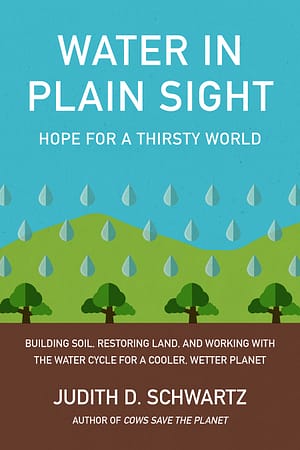Minerals in Your Farm’s Water

Minerals from soil and outside water sources find themselves in irrigation systems. When you water your land, these minerals infiltrate the soil and change its composition. Your plants are more impacted by their presence than meets the eye, but what exactly is the relationship?
The following is an excerpt from Water in Plain Sight by Judith Schwartz. It has been adapted for the web.
When it comes to irrigation, water is not simply water, [John] Kempf says. He means that the sources of water used for crops—be it well, river or reservoir—vary as to the mineral salts that they carry. The degree to which salts are present in water is referred to as “hardness,” generally described in terms of grains per gallon. (“Salt” in this context is not what you’d sprinkle on scrambled eggs, but the combination of elements with a positive charge [cation] and negative charge [anion].) Kempf says that poor water quality, specifically water with high levels of calcium carbonate (lime), is a problem not often acknowledged in public discussions of agriculture—but one that affects crop production and, ironically, leads to a higher use of water.
“The level of minerals affects not only plants’ ability to absorb water, but also how the plant can absorb nutrition,” says Kempf. “Hard water requires more energy, and therefore nutrition, to break it down. When water quality is poor, more water is required.” Farms do regularly test for water quality, and he says that when a potential client’s water source has more than five grains per gallon he recommends that it be treated.
“When farms irrigate with poor-quality water there are multiple effects,” he says. “It ties up all the nutrients that have been applied in the form of fertilizers. It significantly suppresses soil biology. And what often happens is that sodium and calcium bicarbonates accumulate in the soil profile. This leads to salinity.”
By binding nutrients and inhibiting biological processes in the soil, hard water undermines the plants’ ability to reach higher stages of health. This results in less-resilient crops and precludes the water-saving efficiencies that characterize robust plants. Plus, additional water may be needed to correct the problems associated with poor-quality water. For example, soil salinity is typically addressed by flushing the area with large amounts of water. That’s why salinity tends to be a problem in dryer areas like Australia and the Northern Great Plains in Canada and the United States. Here in Vermont, for example, our copious rains would easily wash out excess saltiness. However, Kempf is not talking only about places like California, where he says the situation is endemic. “Ohio, Pennsylvania and the entire Midwest have this problem,” he says. “But no one talks about it.”
At the close of each growing season, the Advancing Eco Agriculture team gathers for a debriefing. “We sit around as a group and go through our entire list of customers,” Kempf says. “Who got the results that we would have expected? And whose results were we not satisfied with? The farmer might be ecstatic. He might have gotten a 20 or 30 percent increase in yield. But in many cases we may feel there’s still a lot left on the table here, much opportunity for improvement.

The company sets a limit of five grains of hardness per gallon for foliar water and ten grains for irrigation. “Eighty-five percent of all the water used on farms in this country falls into this spectrum—in excess of five grains per gallon,” Kempf says. “We don’t hear about it in the Midwest because we get rain that flushes the toxins out of the soil. If we did not get rain we would have the same problems as in California to a lesser degree.”
It’s impossible to fully address water quality without discussing nitrogen. According to Christine Jones, farmers globally apply more than $100 billion in nitrogen fertilizers to their crop fields and pastures each year. Less than half of this is actually taken up by plants. The remainder, between 60 and 90 percent, “is leached into water, volatized into the air or immobilized in soil.” That excess nitrogen will inevitably cause problems. In terms of the atmosphere, increased fertilizer use is associated with the rise in emissions of nitrous oxide, a greenhouse gas with 300 times more impact than CO2. As for water, the USDA’s Economic Research Service estimates that removing nitrates from municipal water supplies costs Americans more than $4.8 billion each year. We can thank excessive use and poor management of nitrogen (and phosphorus) fertilizers for algae blooms and the 6,000-square-mile dead zone in the Gulf of Mexico. Because nitrogen fertilizers are relatively cheap, farmers have an incentive to apply more rather than less. The UN’s Food and Agricultural Organization suggests that nitrogen fertilizer use worldwide will continue to grow, surpassing 200 million metric tons (220 million tons) in 2018.
Jones says the ecological fallout of widespread nitrogen fertilizer use goes far beyond pollution. Inorganic nitrogen alters biological systems in the soil in a way that results in a greater use of water. The problem, as I heard her articulate it at the 2014 Quivira Conference in Albuquerque, is that “in pursuit of yield we’ve uncoupled the linkages between carbon, nitrogen and water.”
If irrigation is the story of farming, nitrogen is what drives the story of the Green Revolution. All living things require nitrogen; nitrogen compounds, such as amino acids, are central to the production of proteins. As it happens, there’s plenty of nitrogen around; it accounts for 78 percent of our atmosphere. However, the N2 gas is very stable, and not available to plants. The nitrogen needs to be “fixed”—its bonds severed—via lightning or nitrogen-fixing bacteria in the soil or in the root nodules of legumes. Usable nitrogen is also present in plant and animal waste, albeit released slowly. Keeping enough nitrogen in the system has been an ongoing challenge for farmers. Most relied on manure, composting, and crop rotation or cover crops, particularly from plants in the legume family, like peas and clovers.
In terms of water, Jones says, “we now know that in order to sequester carbon, we also need to sequester nitrogen. The building of soil aggregates through carbon and nitrogen co-sequestration results in greater water infiltration, less evaporation and greater water-holding capacity. Nitrogen must be obtained through a microbial intermediary in order for carbon to be channeled to the soil. What happens when we interrupt the cycle is that we start to lose function in soils. The plant is in the drivers’ seat, but needs microbial partners.”
Jones laments that the way agricultural research is conducted distorts our understanding of the plant-soil system in what John Kempf calls “the real world.” “Experiments are undertaken in greenhouses and laboratories in ways that reduce the influences of biological processes,” she says. “To reduce ‘background noise,’ inputs are tested in a homogenous, often sterile environment. If experiments were undertaken in biologically active soil they would often get totally different results.”
Can we reconnect carbon, nitrogen and water in our agricultural systems? Think about how vibrant our crops could be. And how much water we could save.
Recommended Reads
Recent Articles
This long-lived perennial legume is used for forage and erosion control. Kudzu is edible with many medicinal uses and other applications. Pollinators of all kinds love its prodigious lavender blooms!
Read MoreMove aside, maple! We have two new syrups to add to the table. Read on for insights on tapping, selling, and eating syrup from walnut & birch trees.
Read MoreWhy is modern wheat making us sick? That’s the question posed by author Eli Rogosa in Restoring Heritage Grains. Wheat is the most widely grown crop on our planet, yet industrial breeders have transformed this ancient staff of life into a commodity of yield and profit—witness the increase in gluten intolerance and ‘wheat belly’. Modern…
Read MoreDid you ever wonder how leeks, kale, asparagus, beans, squash, and corn have ended up on our plates? Well, so did Adam Alexander, otherwise known as The Seed Detective. The following is an excerpt from the The Seed Detective by Adam Alexander. It has been adapted for the web. My Seed-Detective Mission Crammed into two…
Read MoreMost people know that the big man in the North Pole has a team of reindeer waiting to deliver presents, but not as many know who is taking care of these animals behind the scenes: the Sámi people of Norway. This is an excerpt from The Reindeer Chronicles by Judith D. Schwartz. It has been…
Read More








